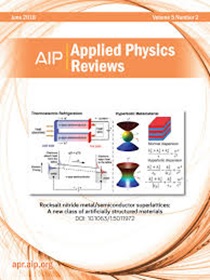Co/MoS2/Co磁性隧道结的研究
IF 11.6
1区 物理与天体物理
Q1 PHYSICS, APPLIED
引用次数: 0
摘要
由二维范德华异质结构组成的磁隧道结(MTJ)被认为是一种比传统的磁隧道结获得更大的隧道磁电阻(TMR)的可行方案。界面上的自旋输运不仅受到布里渊区(BZ)滤波的影响,还受到界面键的影响。本文主要研究了2H二硫化钼(MoS2)范德华层作为隧道势垒,钴(Co)作为电极。由于Co和MoS2在折叠的水平BZ中的动量分辨传输不匹配,导致自旋过滤效率低下,因此TMR较低,因此没有达到期望的水平。研究了界面键对自旋输运和磁各向异性的影响。键的方向决定了界面Co的各向异性,垂直键稳定了垂直磁各向异性(PMA),而非垂直键导致了面内磁各向异性(IMA)。下面的层显示PMA,因此两种类型的MTJ总体上都支持PMA,而物理吸收的MTJ更强。在费米能级附近,由于散射中心阻碍了自旋注入,电子密度与透射率之间的正相关关系被化学键削弱了。我们的工作进一步加强了BZ滤波在控制TMR和MTJ设计原则中的重要性,以及键如何影响整体器件性能。本文章由计算机程序翻译,如有差异,请以英文原文为准。
Insights into the Co/MoS2/Co magnetic tunnel junctions
Magnetic tunnel junctions (MTJ) composed of two-dimensional (2D) van der Waals heterostructures are proposed to be a plausible scheme to achieve larger tunnel magnetoresistance (TMR) than the conventional MTJs. The spin transport across the interfaces is affected not only by the Brillouin zone (BZ) filtering but also by the interfacial bonds. This work focuses on studying the 2H Molybdenum Disulfide (MoS2) van der Waals layers as the tunnel barrier, and Cobalt (Co) as the electrode. The TMR varies with different adsorption interfaces, yet none have achieved the desired levels because the momentum-resolved transmissions of Co and MoS2 in the folded horizontal BZ do not match well, resulting in inefficient spin filtering and thereby a low TMR. The effects of interfacial bonds on spin transport and magnetic anisotropy are studied. The orientations of bonds determine the anisotropy of the interfacial Co. Vertical bonds stabilize the perpendicular magnetic anisotropy (PMA), while non-vertical bonds cause in-plane magnetic anisotropy (IMA). The layers below exhibit PMA, so both types of MTJs overall support PMA, while the physisorbed MTJ is stronger. The positive relation between the transmission and the electron density near the Fermi level is weakened by the bonds, as the scattering centers hold back the spin injection. Our work further strengthens the importance of BZ filtering in governing TMR and the design principle of MTJ, as well as how bonds affect the overall device performance.
求助全文
通过发布文献求助,成功后即可免费获取论文全文。
去求助
来源期刊

Applied physics reviews
PHYSICS, APPLIED-
CiteScore
22.50
自引率
2.00%
发文量
113
审稿时长
2 months
期刊介绍:
Applied Physics Reviews (APR) is a journal featuring articles on critical topics in experimental or theoretical research in applied physics and applications of physics to other scientific and engineering branches. The publication includes two main types of articles:
Original Research: These articles report on high-quality, novel research studies that are of significant interest to the applied physics community.
Reviews: Review articles in APR can either be authoritative and comprehensive assessments of established areas of applied physics or short, timely reviews of recent advances in established fields or emerging areas of applied physics.
 求助内容:
求助内容: 应助结果提醒方式:
应助结果提醒方式:


